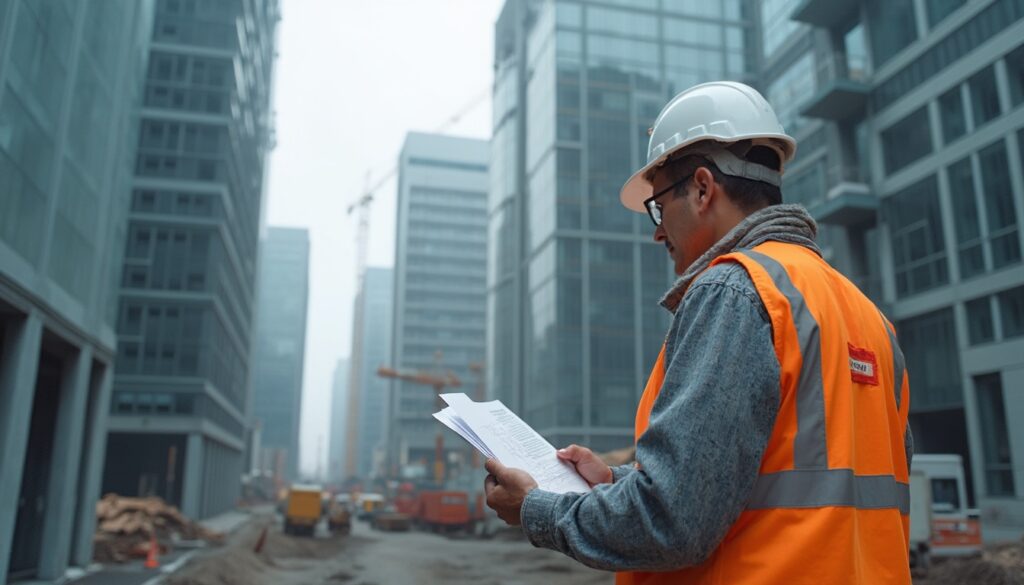Understanding the fundamentals of construction hindrance according to VOB
A construction hindrance in the sense of § 6 para. 1 VOB/B occurs when the continuation of your construction work is hindered or interrupted by an unforeseen circumstance. It is crucial that the cause does not lie within your own area of responsibility. A typical example is when preconditions from other trades are not completed on time. This differentiates the hindrance from self-inflicted delays for which you would be liable. The VOB/B provides a clear framework for dealing fairly with these disruptions, but the burden of proof lies 100% with the contractor. Therefore, a clean delineation and documentation are the first step to securing your claims. How you can use this efficient defect management to support you is an important factor. Without precise documentation of the causes, enforcing claims becomes difficult.
Create the formal and timely hindrance notice
As soon as you notice a hindrance, you must report it in writing ‘immediately’ in accordance with § 6 para. 1 VOB/B. Although a verbal notice is theoretically possible, written form is essential for 100% of cases due to evidential reasons. The notice serves to inform and warn the client so they can eliminate the disruption. A delayed notice can lead to the loss of your claims for the period prior to the notification. An uninterrupted digital construction log can serve as evidence here. For an effective notice, you must clearly outline the following points:
- Concrete description of the hindering circumstances.
- Explanation of which of your tasks cannot be executed because of this.
- Reference to the actual, current construction process, not just to the theoretical schedule.
- Expected duration of the hindrance, if already foreseeable.
This detailed communication enables the client to take countermeasures and secures your position for further steps.
Deriving legal consequences and claims from a construction hindrance
An acknowledged construction hindrance triggers specific legal consequences. The most important is the extension of the execution deadlines by the duration of the hindrance, plus an additional cost for the resumption of work. This effectively protects you from penalties for delays. A claim for an extension of the construction time is often the first consequence. If the client is responsible for the hindrance, you can also demand compensation according to § 6 para. 6 VOB/B. This may include the costs for holding personnel and equipment during the standstill, which can quickly reach four-digit amounts per day. If an interruption lasts longer than 3 months, § 6 para. 7 VOB/B grants both parties the right to terminate the contract. The assertion of these claims stands and falls with the quality of your previous notice and documentation. The precise quantification of the claims is the next logical step.
Utilize complete documentation as the key to success
In case of a dispute, you must conclusively demonstrate the hindrance and its effects 100%. Incomplete documentation is the most common reason for rejected claims. Providing proof requires timely and detailed recording of all relevant facts. Manually taking notes and assigning photos is error-prone and costs at least 30 minutes of pure administrative time per incident. This is where Valoon comes in. Your employees can report a hindrance directly from the construction site via WhatsApp. Every message, every photo, and every video is automatically time-stamped and securely archived in the digital construction protocol in a legally secure manner. This enables you to create a legally valid documentation effortlessly that supports your claims. This seamless process ensures that no information is lost and you are well-prepared in case of an emergency.
Proactively manage common causes of construction hindrances
Many hindrances arise from recurring patterns in the construction process. Knowledge of these risks allows for proactive intervention. The most common causes that trigger a construction hindrance according to VOB include:
- Delayed or missing planning documents from the client.
- Incomplete preconditions from other trades not finished on time.
- Subsequent change requests from the client that disrupt the process.
- Unexpected weather conditions that exceed normal levels.
- Interventions by authorities or delayed permits.
Transparent and rapid communication, as enabled by Valoon via WhatsApp, can defuse many of these issues early on. A simple photo of an unfinished precondition sent to the project management can accelerate processes by days and often avoid a formal hindrance. Thus, reactive damage control becomes active risk management.
Conclusion: Your advantage with Valoon
The correct handling of a construction hindrance according to VOB is not a bureaucratic end in itself but a crucial tool for risk minimization. It secures your claims for extensions of construction time and financial compensation. Valoon transforms the complex requirement of legally secure documentation into a simple process. By using WhatsApp on-site, securing evidence becomes child’s play, and acceptance within the team is guaranteed 100%. Protect your company from unnecessary costs and legal disputes. Book your free demo now and see how Valoon simplifies and secures your processes.
More Links
Construction Professor provides information and explanations about the hindrance notice in construction.
VOB offers a magazine article addressing the hindrance notice.
VOB-Online deals with construction hindrance, compensation, and claims related to VOB.
Forum Verlag provides expertise on the subject of hindrance notices in construction and building management.
WEKA offers a free download for a template for the hindrance notice.
Construction Professor explains claims for damages in connection with hindrance and interruption in construction.
Wikipedia provides an article about the regulations on awarding and contracting construction services (VOB).
Wikipedia provides an article about VOB/B (General Terms and Conditions for the execution of construction services).
FAQ
What is the difference between a hindrance according to VOB and one according to BGB?
The VOB/B contains a detailed regulation on hindrance in § 6, including notification and legal consequences. The BGB does not directly mention the concept of hindrance; here, general regulations such as the client’s delay of acceptance (§ 642 BGB) apply, which are less specific.
How quickly must a hindrance notice be made?
The notice must be made ‘immediately’, that is, without undue delay, as soon as you become aware of the hindrance. In practice, this usually means within 1-3 working days.
What can I do if the client rejects the hindrance notice?
A rejection by the client does not make the notice invalid. You should continue to document the hindrance and its consequences meticulously. In the event of a dispute, a court will decide on the validity of your notice and the resulting claims.
Do I need to quantify the exact additional costs in the hindrance notice?
No, the first notice serves for information and warning. The precise quantification of additional costs or the exact extension of deadlines is not immediately required but must be derivable and documentable later.
To whom should I address the hindrance notice?
The notice should always be directed directly to the client as your contracting partner. A communication only to the architect or construction management is often insufficient unless they are explicitly designated as representatives of the client.
How does Valoon specifically help with a construction hindrance?
Valoon enables your employees to report hindrances via WhatsApp with photos and text. This information is automatically saved with a timestamp in the central construction log. This creates a complete, legally secure documentation without additional effort and serves as perfect evidence for your claims.








